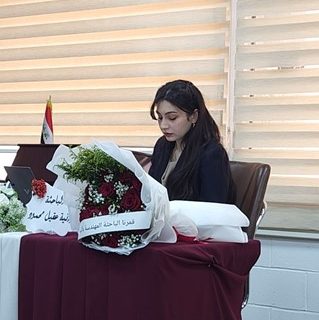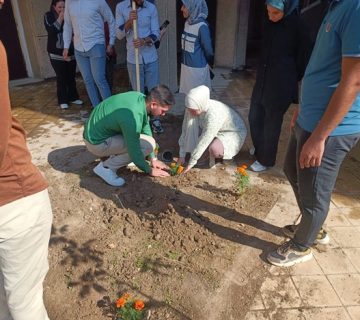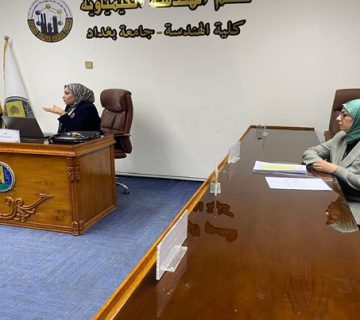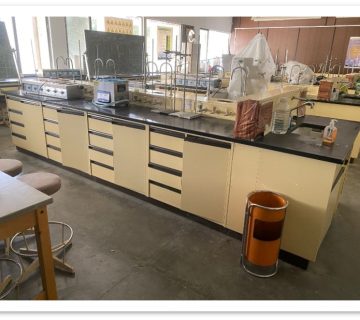The Chemical Engineering Department at the College of Engineering, University of Baghdad, held an PhD. thesis examination titled:
“ Application of Sonochemical Extracted Cellulose Nanopapers Loaded with graphene oxide for removal of disinfectants residues from wastewater “
By the PhD. student Watheq Kareem Salih supervised by Prof. Dr. Sawsan A. M. Mohammed and Basma Abbas Abdulmajeed. The examination committee consisted of Prof. Dr. Wadood Taher Mohammed as Chairman and the membership of Prof. Dr. Anees A. Kadhom , Prof. Dr. Muthana Jabar Ahmed, Prof. Dr. Mahmood Kazal Hummadi and Assist. Prof. Dr. Rasha Habeeb Salman . After conducting the public discussion and listening to the student’s defense, the thesis was accepted. The thesis was summarized as follows:
The global challenges are increased day after day due to various reasons. One of these challenges is water pollution and water quality that has become an international concern because it has detrimental impacts on both marine life and human health besides its harm effect on the agricultural field. In this work, cellulose nanopapers extracted from Iraqi date palm frond biomass loaded with graphene oxide (GO) synthesized by Tour method.
The work consisted of successive stages; in first stage, GO was synthesized using two methods Tour and modified. The former was selected because of its characteristics compared to modified method that did not produce high quality GO in this work. In addition, two graphite types, natural and synthetic, were detected. Furthermore, different parameters were investigated such as, reaction temperature (26, 36 and 46 ˚C), sulfuric acid / phosphoric acid volumetric ratio (0:10, 5: 5, 9: 1, and 10:0), graphite / potassium permanganate oxidant weight ratio (1:2, 1:3, 1:4, 1:5, 1:6) and time of reaction (120 and 180 minutes). Different responses were obtained depending on the oxidation degree that was specified via X-ray diffraction test (XRD). The optimum produced GO was chosen when sulfuric /phosphoric acid volumetric ratio (9:1), Graphite/ potassium permanganate oxidant weight ratio (1:4), reaction time (180 minutes) at 36 ˚C. The optimal GO was subjected to characterization tests to specify its properties.
Furthermore, Cellulose extraction from Moringa Olifera was not fruitful because of its cellulose amorphous nature; therefore it was not suitable for the present work. Thus, cellulose was extracted from the Iraqi date palm frond. The composition tests showed that the frond leaf cellulose content was the highest ratio compared to other parts (stealth and spine). New extraction was applied to extract cellulose from two forms of frond leaf as powder and fibers..
Room temperature sonochemical extraction was proposed in this work as a novel method to extract cellulose. The cellulose extraction experiments were designed via Taguchi technique to specify the optimal conditions. The proposed extraction method efficiency was assessed depending on cellulose characteristics that were detected using different characterization tests. The extraction optimal conditions were an sodium hydroxide alkaline concentration (4% wt.), ultrasonic alkaline treatment period (120 minutes), Bleacher concentration (15% v./v.), and ultrasonic bleaching time (80 minutes). The results showed that crystallinity of cellulose microcrystalline based leaf fibers (MCF) and cellulose microcrystalline based leaf powder (MCP) were 75%, 72.14% respectively. Fourier-transform infrared spectroscopy (FTIR) test showed the prominent peaks of cellulose and confirmed the elimination of hemicellulose besides traces of lignin. Thermal stability was tested using Thermogravimetric analysis (TGA) of both types showed good stability against increasing temperature. Elemental composition tested by Energy Dispersive X-Ray Analysis (EDX) confirmed that extraction process and washing process were very efficient because there were very small traces of sodium. The specific surface area were (9.300, 11.312) m2/g for MCP and MCF. The morphology investigated by Scanning Electron Microscopy (SEM) showed clearly the cellulose fiber diameter of 53.365 and 71.908 microns for MCP and MCF respectively. Both cellulose forms had high aspect ratios, (16.516 for MCF and 11.836 for MCP) compared with other extracted types by other researchers. The characterization tests proved that room temperature sonochemical extraction method is very powerful technique to produce high quality cellulose. Depending on results of tests, MCF was used to produce nanopaper samples.
Cellulose nanopaper based MCF samples (CNPs) were synthesized using mechanical /suction filtration technique.. Different CNP-GO loadings (0% wt., 1% wt., 3% wt., 5% wt. symbolized as CNP-00, CNP-01, CNP-03 and CNP-05 respectively) were formulated by mixing via homogenizer for 10 min. The samples were characterized using various characterization techniques. The tests showed the success of manufacturing process.
In the last step, GO-nanopaper samples efficiency to remove Cetylpyridinium Chloride residue (CPC) from medical wastewater were investigated to assess its solubility as a new adsorbent for removing the pollutant residues from hygienic wastewater. Different batch adsorption parameters were tested such as adsorbent dose (12.5, 25, 50, 75 and 100 mg/ 25 ml adsorbate), CPC disinfectant concentration ( 50, 100, 150, 200 and 250 ppm), shaking speed (50, 100, 150, 200 and 250 rpm) and shaking time ( 1, 2, 3, 4 and 5 hours). The pH was 8 depending on the point of zero charge test for all experiments that were designed by Taguchi design method. The optimal conditions were calculated by Taguchi analysis. Nanopapers loaded with 3%wt.GO could remove the highest removal ratio (95.23%) when CPC concentration was 250 ppm, 12.5 mg/12.5 ml, 250 rpm shaking time and 2 hr. as shaking period. Eight isotherm models were applied besides four adsorption kinetic models were tested. The results of CNP-03 were fitted with Halsey isotherm model (R2= 0.9987) and with Pseudo 2nd order kinetic model (R2=0.9708). The maximum adsorption capacity was 200 mg/g in addition to the heat adsorption was about 56 KJ.
The results of this work confirmed the possibility of using cellulosic nanopaper loaded with graphene oxide as effective adsorbent to remove CPC residue in specific and treating medical wastewater in general.







